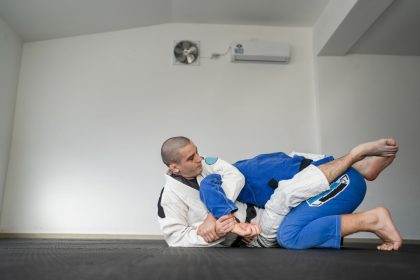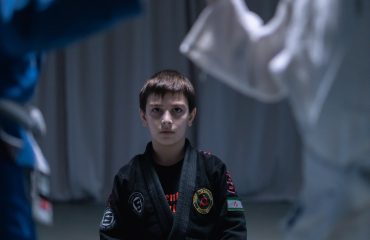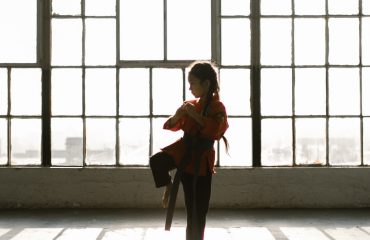
In the world of martial arts, Brazilian Jiu-Jitsu (BJJ) stands out as a unique and highly effective combat system. Central to its philosophy and practice is the art of grappling, a skill that transforms physical confrontations into a chess-like battle of wits and technique. At Noco Jiu-Jitsu and Self-Defense, we explore the essence of grappling in BJJ, diving into its nuances and how it shapes the discipline.
The Essence of Grappling in Brazilian Jiu-Jitsu
Grappling in Brazilian Jiu-Jitsu is not just a set of techniques; it’s a profound language of combat. It involves taking your opponent to the ground, controlling their movement, and applying joint locks or chokeholds to subdue them. This aspect of Jiu-jitsu is what sets it apart from other martial arts, focusing on leverage and technique over brute strength.
The philosophy behind grappling in Brazilian Jiu-Jitsu emphasizes outmaneuvering opponents rather than overpowering them. It’s a testament to the art’s principle that skill and intelligence can triumph over sheer force. In a typical grappling session at Noco Jiu-Jitsu and Self-Defense, practitioners learn to use their body as a cohesive unit, maximizing efficiency and minimizing effort. This approach not only makes BJJ accessible to individuals of all physical capabilities but also instills a deep understanding of body mechanics and control.
Furthermore, the strategic nature of grappling in BJJ cannot be overstated. Each move, from a simple grip to a complex submission, is like a move in a game of chess. Practitioners must think several steps ahead, anticipating and countering their opponent’s strategies. This cerebral aspect of grappling makes every training session at Noco Jiu-Jitsu and Self-Defense a mental workout as much as a physical one. It teaches practitioners the art of patience, the value of foresight, and the importance of adaptability, skills that are invaluable both on and off the mat.
The Historical Roots of BJJ and Grappling
Brazilian Jiu-Jitsu’s roots trace back to the early 20th century, evolving from Japanese Judo and traditional Jiu-Jitsu. The Gracie family, pioneers of BJJ, adapted these techniques to focus more on ground fighting and grappling, creating a martial art that is both practical and adaptable.
The transformation of Brazilian Jiu-Jitsu into its current form is a fascinating tale of cultural exchange and adaptation. When Mitsuyo Maeda, a Japanese Judo master, arrived in Brazil in the 1910s, he befriended the Gracie family and began teaching them the fundamentals of Judo and traditional Jiu-Jitsu. This knowledge transfer was the seed from which BJJ grew. The Gracies, particularly Carlos and Helio Gracie, analyzed these techniques, focusing on adapting them to suit those with a smaller stature or lesser strength. This evolution marked the birth of a martial art where technique and strategy outweighed physical power, making it accessible and effective for all.
Another significant aspect of BJJ’s historical roots is its continual evolution. Over the years, practitioners and competitors have refined and developed new techniques, constantly expanding the art form. This process of innovation is central to the ethos of Brazilian Jiu-Jitsu. The art is not static; it is dynamic and evolving, reflecting the varied influences and creative minds that have contributed to its development. This adaptive nature of BJJ has made it a highly respected and influential martial art globally, attracting enthusiasts from various backgrounds, all drawn to its unique blend of physical and mental discipline.
Learning the Techniques: The Expedition in Grappling
At Noco Jiu-Jitsu and Self-Defense, beginners start on their path by learning the fundamental positions and submissions of grappling. These foundational techniques include the guard, a position where one fights from their back, effectively using their legs for defense and attack; the mount, a dominant top position that offers control over the opponent; and the rear-naked choke, a submission that exemplifies the efficiency of Jiu-jitsu in incapacitating an opponent. These techniques are the building blocks of grappling, providing a solid base from which practitioners can expand their skill set.
But the experience in grappling goes far beyond these basics. As students progress, they are introduced to more complex techniques and variations. This includes learning how to transition smoothly between positions, maintaining control, and applying pressure. They also start to understand the importance of flow and timing, critical elements that turn separate techniques into a cohesive grappling strategy. The adaptability of grappling in Jiu-jitsu shines here, as each practitioner begins to tailor their approach to suit their body type, strengths, and personal style.
This deeper exploration into grappling reveals the artistry and sophistication of Brazilian Jiu-Jitsu. Students begin to see the mat as a canvas where they can express themselves, using techniques not just as methods of control or submission, but as tools for creative problem-solving. The dynamic nature of grappling ensures that no two encounters are the same, providing an endlessly evolving challenge that keeps practitioners engaged and motivated. At Noco Jiu-Jitsu and Self-Defense, we nurture this process, guiding our students as they transform from novices into adept grapplers, capable of mastering the complexities of Jiu-Jitsu with skill and confidence.
The Mental and Physical Benefits of Grappling
Grappling is not just a physical pursuit; it’s a mental one as well. Practitioners learn patience, strategy, and adaptability. Physically, it enhances flexibility, strength, and cardiovascular health. The practice of grappling in BJJ is as much about building character and resilience as it is about learning self-defense.
Beyond the visible physical benefits, grappling in Brazilian Jiu-Jitsu fosters mental acuity and emotional well-being. As practitioners engage in this intricate dance of maneuvers, they develop a heightened sense of awareness, not just of their opponent’s movements but of their own body and mind. This heightened awareness leads to improved focus and mental clarity, both on and off the mats. In the high-pressure scenarios of grappling, practitioners learn to manage stress, think clearly under pressure, and make swift, strategic decisions. These mental skills are invaluable, transcending the boundaries of the dojo and applying them to everyday life challenges.
Furthermore, the discipline required to master grappling techniques in BJJ promotes a strong sense of self-discipline and self-esteem. Regular practice instills a sense of routine and commitment, qualities that are beneficial in all aspects of life. The exploration through grappling is also a voyage of personal growth, where each session is an opportunity to learn not just about new techniques but about oneself. As practitioners overcome challenges and reach new milestones in their grappling skills, they build confidence and a sense of accomplishment. This confidence is empowering, encouraging individuals to face life’s challenges with the same resilience and determination they display on the mats.
Grappling Tournaments: Testing Skills and Strategy
Competitions are a cornerstone of Brazilian Jiu-Jitsu, offering grapplers a platform to test their skills. These tournaments focus on grappling techniques, with points awarded for positions and submissions. They are a testament to the effectiveness and depth of grappling in Jiu-jitsu. Participants, from novices to seasoned practitioners, converge to showcase their mastery and adaptability in real-time scenarios. This competitive environment provides an invaluable learning experience, highlighting the dynamic nature of grappling where strategy and quick thinking are as crucial as physical prowess.
These tournaments also serve as a melting pot of different grappling styles within BJJ, each bringing unique approaches and techniques to the mat. From the precise control of the GI tournaments to the fast-paced nature of No-Gi competitions, athletes get to experience and adapt to varying forms of grappling challenges. This diversity not only enriches the practitioner’s skill set but also fosters a deeper appreciation for the art. Observing and participating in these competitions can be incredibly inspiring, driving individuals to refine their techniques and understanding of the art.
In these tournaments, the principles of BJJ are put to the test, underlining the importance of continuous learning and adaptation. The outcomes are often unpredictable, adding to the excitement and allure of the sport. For many, these events are not just about winning medals but about personal growth, testing limits, and the pure joy of engaging in the art of grappling. As the community around these tournaments grows, so does the legacy of Brazilian Jiu-Jitsu, solidifying its place as a respected and influential martial art worldwide.
The Role of Grappling in Self-Defense
BJJ’s grappling techniques are highly effective for self-defense. They allow a smaller person to defend themselves against a larger adversary by using leverage and technique. This aspect makes BJJ a preferred martial art for self-defense, especially for those seeking a non-violent way to neutralize threats. In scenarios where confrontations occur, the ability to control and subdue an aggressor without causing significant harm is invaluable. Grappling teaches not only physical control but also restraint, ensuring that self-defense remains just that—defensive rather than offensive.
Moreover, the strategic nature of grappling in Brazilian Jiu-Jitsu empowers individuals to think critically under pressure. Practitioners learn to assess situations quickly, identifying potential threats and reacting accordingly. This mental acuity, developed through regular training and sparring, is a crucial element of self-defense. It’s not just about having the physical skills to protect oneself but also about possessing the mental sharpness to avoid dangerous situations altogether. At Noco Jiu-Jitsu and Self-Defense, we emphasize this holistic approach to self-defense, where the mind and body work in harmony to ensure personal safety and confidence in any situation.
The Community Aspect of Grappling in BJJ
Grappling fosters a sense of community. At Noco Jiu-Jitsu and Self-Defense, we witness daily how the shared challenge of grappling brings people together, creating bonds that extend beyond the mat. The respect, camaraderie, and mutual support are pillars of the BJJ community. This community spirit is reinforced through regular training sessions, seminars, and social events, where practitioners of all levels come together to learn, share, and grow. It’s a place where lifelong friendships are formed, where each member is both a student and a teacher, contributing to a collective adventure of mastering the art of Brazilian Jiu-Jitsu. The mat becomes a microcosm of society, teaching lessons of respect, humility, and perseverance, transcending the physical aspects of grappling and leaving a lasting impact on the personal lives of its practitioners.
In the domain of martial arts, Brazilian Jiu-Jitsu, with its focus on grappling, stands as a unique and empowering discipline. It offers not just a method of self-defense, but a route to personal growth, community, and understanding the deeper aspects of combat. At Noco Jiu-Jitsu and Self-Defense, we continue to explore and teach this fascinating art, inviting everyone to discover the profound power of grappling in Jiu-Jitsu.




